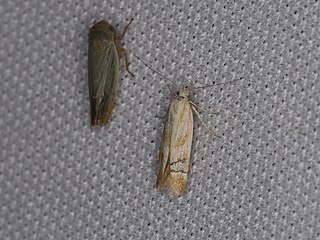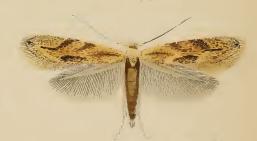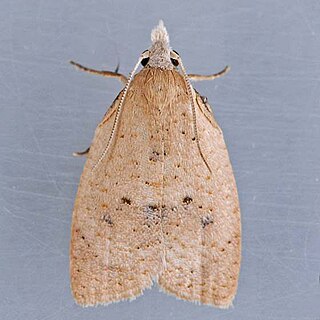
Lutrochidae is a family of water beetles with a single genus Lutrochus sometimes known as "travertine beetles". There are around 21 species native to the Americas from the southern United States to Brazil.

Caryocolum blandella is a moth of the family Gelechiidae. It is found from central and northern Europe to the Ural Mountains and southern Siberia.

Sirex juvencus is a species of horntail found in Europe, Siberia, Sakhalin Island, Japan, the Philippines, Algeria and several other countries. Its common name is steely-blue wood wasp because of its color.

Lampronia corticella, the raspberry moth, is a moth of the family Prodoxidae. The species was first described by Carl Linnaeus in his 1758 10th edition of Systema Naturae. It is found in most of Europe, except Iceland, the Iberian Peninsula and the Balkan Peninsula. It is an introduced species in North America, where it was first detected in New Brunswick, Canada, in 1936.

Platylesches galesa, the white-tail hopper or black hopper, is a butterfly of the family Hesperiidae. It is found in Transvaal, Mozambique and Zimbabwe. It is common in forest and woodland.

Bucculatrix cristatella is a species of moth of the family Bucculatricidae. It is found in most of Europe. It was described in 1839 by Philipp Christoph Zeller.
Erechthias flavistriata, the sugarcane bud moth, is a moth of the family Tineidae. It was described by Lord Walsingham in 1907 from Hawaii, but is probably an introduced species. It is found in large parts of the Pacific Rim including the Marquesas, Rapa Iti, Fiji, the New Hebrides, the Kermadec Islands, the Solomons, Java and Malaya. It has been spread widely by man and probably has travelled to many islands throughout much of the Pacific in the canoes of the native peoples.
Crocidosema marcidellum is a moth of the family Tortricidae. It was first described by Lord Walsingham in 1907. It is endemic to the Hawaiian islands of Kauai and Oahu.

Paraclemensia acerifoliella, the maple leafcutter moth, is a moth of the family Incurvariidae. It is found from south-eastern Canada and the north-eastern United States, south to the tip of the Appalachian Mountains in western North Carolina and possibly north-western Georgia.

Mirificarma eburnella is a moth of the family Gelechiidae. It is found in western, central and southern Europe and extends to North Africa, the Middle East and Russia. It is also found in California, United States, where it is presumed to have been introduced.

Bucculatrix bechsteinella is a moth of the family Bucculatricidae. It was described by Johann Matthäus Bechstein and Georg Ludwig Scharfenberg in 1805. It is found in most of Europe, except Greece and Bulgaria.
Caryocolum inflativorella is a moth of the family Gelechiidae. It is found in Slovakia, Hungary, Romania and North Macedonia.

Scrobipalpa samadensis, the buck's-horn groundling, is a moth of the family Gelechiidae. It is found in most of Europe and Russia.

Sparganothoides lentiginosana, the lentiginos moth, is a species of moth of the family Tortricidae. It is found in the United States from Maryland to Florida, west to Arkansas, Texas and Oklahoma, ranging south to Mexico in Tamaulipas and Veracruz. It is found in a wide range of habitats, ranging from urban areas to mixed pine-deciduous woodlands at low elevations.

Cnephasia longana, the omnivorous leaftier moth, long-winged shade or strawberry fruitworm, is a moth of the family Tortricidae. It was described by Adrian Hardy Haworth in 1811. It is native to western Europe. It is an introduced species in western North America. The species has also been reported from north-western Africa and Asia. The habitat consists of downland and rough ground.
Rhectocraspeda periusalis, the eggplant webworm moth, is a moth in the family Crambidae. It was described by Francis Walker in 1859. It is found in the West Indies and from the United States, where it has been recorded from Florida, North Carolina, Ohio, Oklahoma, South Carolina and Tennessee, south through Mexico and Central America to South America, including Ecuador, Brazil, Guyana, Trinidad and Tobago and Suriname.

Spatalistis bifasciana is a species of moth of the family Tortricidae. It is found in most of Europe.
Aquatica ficta is a species of firefly found in Taiwan and parts of China. It was formerly placed in the genus Luciola. Its habitat is still water, and the larvae are aquatic.

Aquatica lateralis, known as "heike-botaru" (ヘイケボタル) in Japanese, is a species of firefly found in Russia, Japan and Korea. It was formerly placed in the genus Luciola. The larvae are aquatic and live in rice paddies.

Epinotia abbreviana is a moth of the family Tortricidae. It is found in Europe and was first described by Johan Christian Fabricius in 1794.












